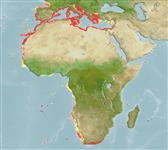>
Eupercaria/misc (Various families in series Eupercaria) >
Sparidae (Porgies)
Etymology: Diplodus: Greek, diploos = twice + Greek, odous = teeth (Ref. 45335).
More on author: Lowe.
Environment: milieu / climate zone / depth range / distribution range
Ökologie
seewasser riff-verbunden; ozeanodrom (Ref. 51243); tiefenbereich 30 - 300 m (Ref. 3688). Subtropical; 47°N - 35°S, 19°W - 36°E
Eastern Atlantic: Bay of Biscay and the Mediterranean to the Strait of Gibraltar and South Africa including Madeira and the Canary islands, but absent from Cape Verde, off Senegal and the Gulf of Guinea.
Length at first maturity / Size / Gewicht / Alter
Maturity: Lm 27.3, range 22 - ? cm
Max length : 55.0 cm TL Männchen/unbestimmt; (Ref. 2715); common length : 35.0 cm TL Männchen/unbestimmt; (Ref. 2715); max. veröff. Gewicht: 2.7 kg (Ref. 40637)
Benthopelagic on the shelf, on rocky bottoms from 30 to 80 m depth, but may also occur down to 300 m on muddy bottoms. Forms schools of 4 or 5 individuals of different sizes. Omnivorous, feeds on small invertebrates and seaweeds (Ref. 4781).
Also Ref. 4781.
Bauchot, M.-L. and J.-C. Hureau, 1990. Sparidae. p. 790-812. In J.C. Quero, J.C. Hureau, C. Karrer, A. Post and L. Saldanha (eds.) Check-list of the fishes of the eastern tropical Atlantic (CLOFETA). JNICT, Lisbon; SEI, Paris; and UNESCO, Paris. Vol. 2. (Ref. 3688)
IUCN Rote Liste Status (Ref. 130435)
Bedrohung für Menschen
Harmless
Nutzung durch Menschen
Fischereien: weniger kommerziell; Sportfisch: ja
Tools
Zusatzinformationen
Download XML
Internet Quellen
Estimates based on models
Preferred temperature (Ref.
123201): 13.3 - 17.9, mean 14.9 °C (based on 141 cells).
Phylogenetic diversity index (Ref.
82804): PD
50 = 0.5000 [Uniqueness, from 0.5 = low to 2.0 = high].
Bayesian length-weight: a=0.01122 (0.00718 - 0.01752), b=3.07 (2.94 - 3.20), in cm total length, based on LWR estimates for this species & Genus-body shape (Ref.
93245).
Trophic level (Ref.
69278): 3.0 ±0.37 se; based on food items.
Widerstandsfähigkeit (Ref.
120179): niedrig, Verdopplung der Population dauert 4,5 - 14 Jahre. (Preliminary K or Fecundity.).
Fishing Vulnerability (Ref.
59153): Moderate to high vulnerability (55 of 100).
Climate Vulnerability (Ref.
125649): Low to moderate vulnerability (26 of 100).
Nutrients (Ref.
124155): Calcium = 25 [11, 41] mg/100g; Iron = 0.555 [0.295, 1.054] mg/100g; Protein = 20.1 [19.0, 21.2] %; Omega3 = 0.226 [0.116, 0.462] g/100g; Selenium = 22.8 [10.8, 41.7] μg/100g; VitaminA = 38.1 [11.0, 125.1] μg/100g; Zinc = 0.786 [0.517, 1.182] mg/100g (wet weight);
